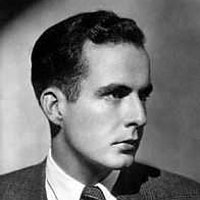Samuel Barber (1910-1981)
Born March 9, 1910 in West Chester, PA.
Died January 23, 1981 in New York City.
Adagio for String Orchestra, Op. 11
Composed 1936.
First Performance: November 5, 1938 with Arturo Toscanini conducting the NBC Symphony.
Instrumentation: string orchestra (first and second violins with divided parts, viola divided, cello divided and bass)
Duration: ~ 8 minutes.
Samuel Barber was a prodigy who was surrounded by music as a youth. His aunt was Metropolitan opera contralto Louise Homer. (Barber dedicated the Adagio “To my aunt and uncle, Louise and Sidney Homer.”) He entered the newly opened Curtis Institute in Philadelphia at the age of 14 as one of its first students studying piano, voice and composition. Barber won the (American) Prix de Rome for which he wrote the Symphony No. 1
in Rome. Much later his opera Antony and Cleopatra
opened the new Metropolitan Opera house in 1966. Unfortunately it was his own Actium due to many circumstances beyond his control.
In 1936 Barber wrote his String Quartet No. 1 in B Minor Op. 11 which was first performed later that year in Rome by the Pro Arte String Quartet. This quartet’s second movement which is marked “molto adagio espr. cantando” (very slowly, singing expressively) was exceptionally well received. He then scored this movement as a stand alone work for string orchestra cunningly named Adagio for Strings. Arturo Toscanini – never one to pay the least attention to American composers – actually suggested this transcription to Barber. He premiered the work in 1938 with the NBC Orchestra broadcast over the radio which gained national exposure for the young composer.
Barber’s inspiration for the Adagio was a passage from The Georgics of Vergil
which described how a wave from the middle of the ocean becomes as imposing and powerful as a mountain by the time it reaches shore. It begins with the violins playing a stepwise melody that turns on itself repeatedly over soft sustained chords.

If the opening of The Moldau – a piece in which a small stream becomes mighty then fades away – were slowed down several times there would be a striking resemblance. There is just this one theme throughout. Its other worldly character is underscored by an imperceptible meter and key. It might appear to be B flat minor but it has a closer resemblance to a medieval church mode. The theme is passed from the violins to the violas then finally the cellos. It increases in intensity until it reaches a shattering climax with everyone except the basses playing in the stratosphere. After the climax the mood of the opening returns but this time the theme in the violins is doubled by the violas. The work ends on a F major chord which makes it appear as if it is suspended in mid air with no resolution.
Barber’s recasting of this movement turned out to be only the first in an unending series of transcriptions. Some are serious – I own a CD containing several versions such as brass quintet – to questionable versions for kazoo choir (!?) and money and personal glory oriented music industry products like Trance Music. Barber himself seems to be unable to resist tinkering with it; in 1967 he wrote a version for chorus on the text of the Agnus Dei.
The Adagio is undoubtedly Barber’s most famous work. For a while it was the best selling classical work on iTunes having gained attention through its use in a series of movies beginning with The Elephant Man (1980), then Platoon
(1986), and more recently SiCKO
(2007) among others.
Its reflective mood has made it appropriate for times of tragedy and loss. This tradition began after it was played repeatedly on the radio after FDR’s death. It has since been played for the funerals of luminaries such as Einstein, JFK, and Princess Grace among many others. Ironically Barber specifically requested that it not be played for his own funeral.
It has the power to speak the unspeakable after national tragedies such as the Challenger disaster or the September 11, 2001 attacks. Leonard Slatkin led the BBC Symphony in an unforgettable performance on the last night of the Proms just a few days later. It is America’s great secular hymn of mourning just as Elgar’s Nimrod from his Enigma Variations is for Britain.
Resources
[amazon template=iframe image&asin=B002ZBTWLU][amazon template=iframe image&asin=B000BDGWF8][amazon template=iframe image&asin=B0007PHATW][amazon template=iframe image&asin=B00004T6KQ][amazon template=iframe image&asin=B0000030D8][amazon template=iframe image&asin=B000001GGZ][amazon template=iframe image&asin=B000M9DR6S]
Movies
[amazon template=iframe image&asin=B00003CX9S][amazon template=iframe image&asin=B000F1IQJG][amazon template=iframe image&asin=B000UNYJXQ]
